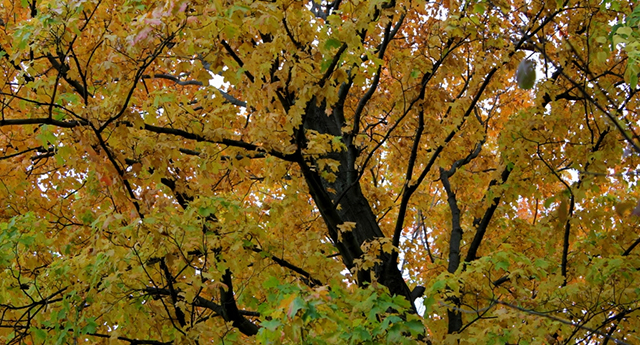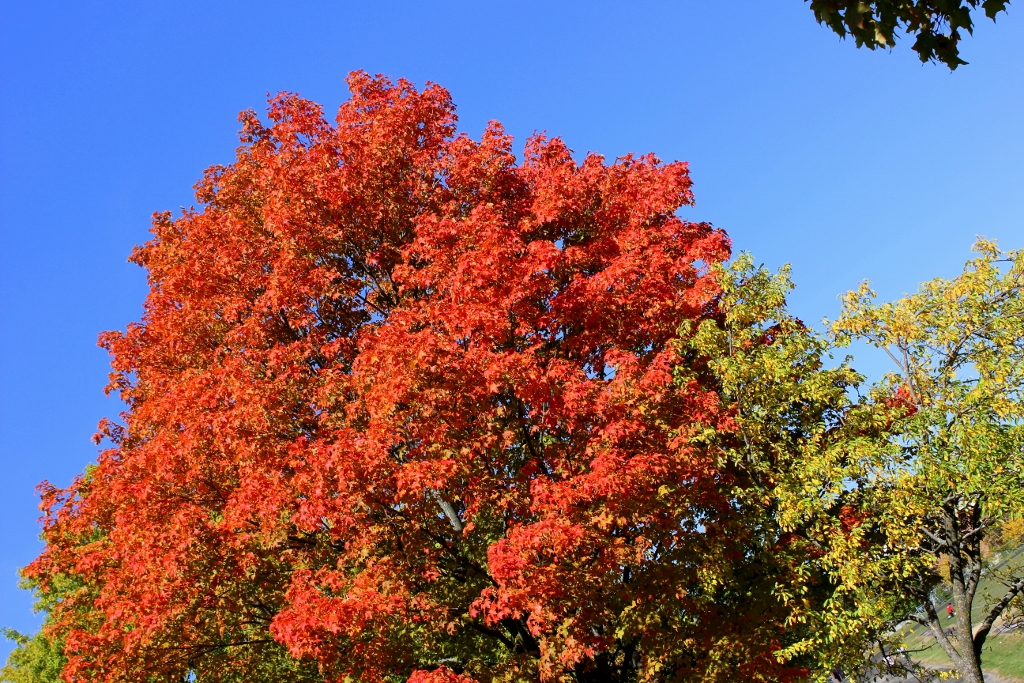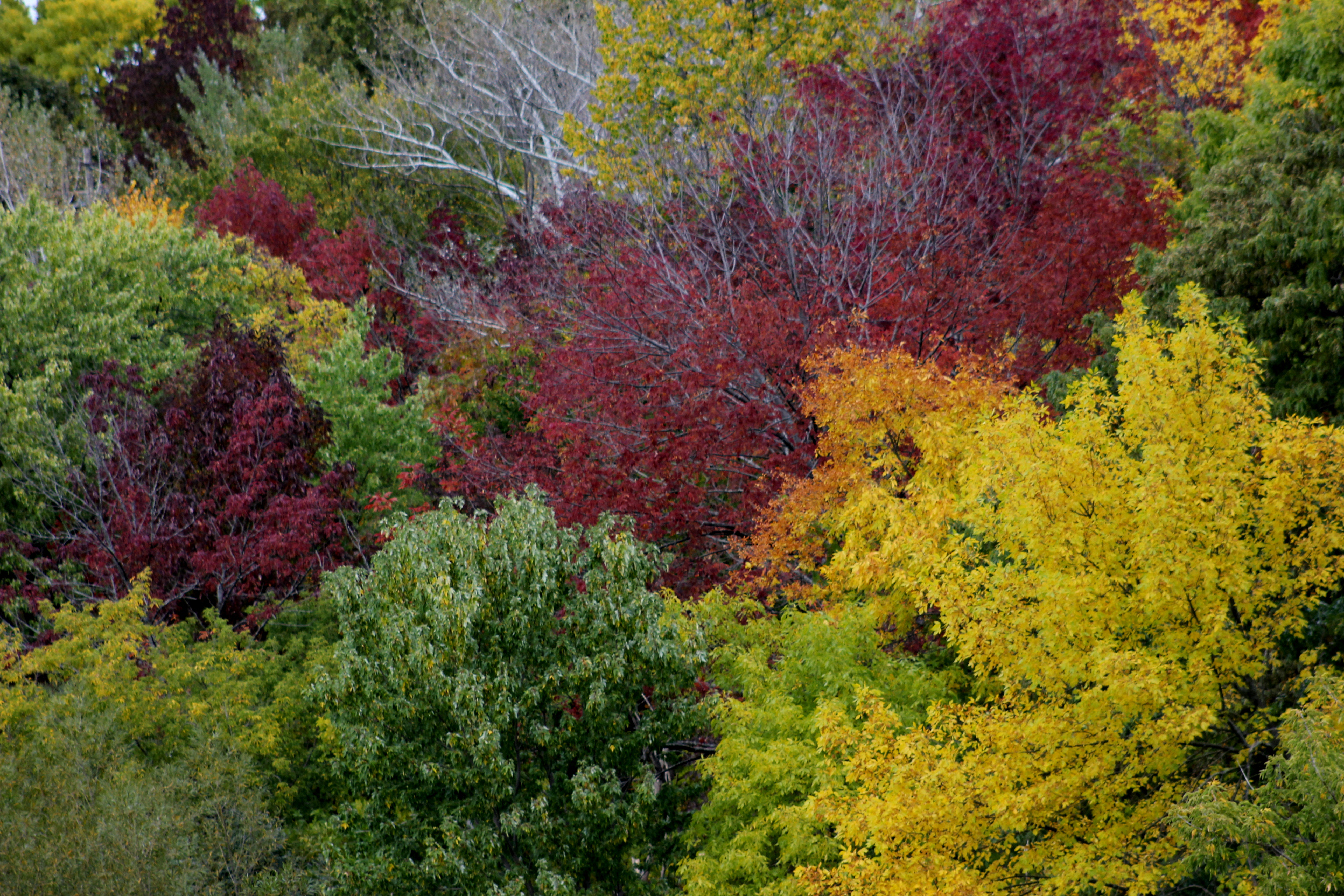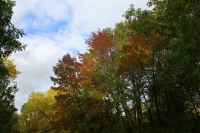In order to understand what trees do during the fall, we need to understand a little bit about what’s happening inside of a tree’s leaves during the summer. During the growing season, leaves that are healthy and productive are usually green. This is because of chlorophyll, which is a compound responsible for photosynthesis. Chlorophyll is really an amazing molecule. When sunlight hits the surface of a leaf, chlorophyll absorbs the sunlight and uses that light energy to turn carbon dioxide and water into sugars, the food that the tree needs to keep growing. Chlorophyll absorbs and uses the red and blue wavelengths of light, and it reflects the green wavelength which is why leaves appear green. Leaves have other photosynthetic compounds which compliment chlorophyll by absorbing other wavelengths of light as well, but those compounds are usually masked to our naked eye during the growing season by the overwhelming amount of chlorophyll.
Throughout the day (no matter the season), leaves are usually being bombarded with way more sunlight than they can possibly use through photosynthesis. Chlorophyll is such an excitable little molecule that when it is exposed to light, it just can’t help but photosynthesize. Like any machine that is constantly run at full throttle, chlorophyll eventually degrades and breaks down in response to this excessive light. During the growing season, chlorophyll molecules are constantly breaking down and being replaced within the leaf. Eventually, when days get shorter and temperatures get lower, the tree starts to hunker down for the winter, so it stops replacing the chlorophyll that is destroyed. When the tree stops synthesizing chlorophyll, the leaf begins to lose its green color, and we can see the colors created by the other compounds that were in the leaf all along.

Carotenoids are photosynthetic compounds that are yellow to orange in color (they absorb the blue to green wavelengths of light). They exist in the leaf all summer long, but we cannot see them because the green color of the chlorophyll drowns out the yellow to orange color of the carotenoids. Without the chlorophyll, the yellows and oranges are able to shine through. Carotenoids are common in lots of plants…they are the compounds responsible for the colors of daffodils, corn, and carrots. There are a bunch of different kinds of carotenoids which exist in different levels in different kinds of leaves, or even in different leaves on the same tree, which accounts for the range in color and brilliance of oranges and yellows.
That explains why some leaves turn yellow and orange, but what about leaves that turn red or purple? Well, that’s a different story entirely.
When a tree gets ready to lose its leaves, it puts all of its time and energy into storing as many nutrients as possible to make it through the winter and into the spring when days start to get longer again. The tree’s leaves are full of nitrogen, phosphorus, potassium, sulfur, and a whole bunch of other compounds that the tree will need to produce new leaves in the spring. Instead of letting all of those compounds fall off in the leaves, the tree puts a lot of energy into transporting all of those nutrients out of the leaf, through the leaf stalk (the petiole), and into the living bark to store through the winter. This phenomenon is called phloem-loading. In fact, trees are able to store and save up to one third of the total amount of nutrients they will need the next year through phloem-loading! The catch: reserving all of these nutrients inside the tree takes a considerable amount of energy.
 Now our tree is presented with a problem: at the very same time that it is trying to shut down its photosynthetic machinery, some of the equipment has to be left intact to make enough sugars and starches for the tree to be able to compile its winter stores. Well, we already know that the tree is shutting down its chlorophyll factories, so when the chlorophyll and carotenoids that already exist in the leaf are degraded and unusable, the tree will not be able to make the energy it needs to finish preparing for winter. We also already know that the leaves are constantly being hit by way more light that they can use, and that the excess light causes the chlorophyll to degrade even faster. What the tree needs is a filter (or a sunscreen) to protect the existing chlorophyll from the extra light.
Now our tree is presented with a problem: at the very same time that it is trying to shut down its photosynthetic machinery, some of the equipment has to be left intact to make enough sugars and starches for the tree to be able to compile its winter stores. Well, we already know that the tree is shutting down its chlorophyll factories, so when the chlorophyll and carotenoids that already exist in the leaf are degraded and unusable, the tree will not be able to make the energy it needs to finish preparing for winter. We also already know that the leaves are constantly being hit by way more light that they can use, and that the excess light causes the chlorophyll to degrade even faster. What the tree needs is a filter (or a sunscreen) to protect the existing chlorophyll from the extra light.
That’s where our red and purple colors come into play. Our clever tree uses up a little of its energy to actively produce compounds called anthocyanins which act as a filter to protect the remaining chlorophyll. These anthocyanins are red to purple in color. Have you ever noticed that the leaves on the outside and the top of individual trees tend to turn red or purple, while the inside leaves will stay yellow or greenish longer? Well, that’s because those leaves are subject to more light bombardment, and therefore produce more sunscreen, the anthocyanins!
Trees that are subject to more sunlight and lower temperatures in fall will  turn darker or more brilliant colors of red or purple. Some trees are naturally more suited to more light bombardment (like aspens or birches that normally grow in full, hot sunlight). Those trees do not need to produce anthocyanins to protect their chlorophyll, so they may only turn yellow. Brillance and shade of color varies a lot between trees and from year to year. Subtle differences in temperature, microclimate, and moisture cause this spectrum of leaf color.
turn darker or more brilliant colors of red or purple. Some trees are naturally more suited to more light bombardment (like aspens or birches that normally grow in full, hot sunlight). Those trees do not need to produce anthocyanins to protect their chlorophyll, so they may only turn yellow. Brillance and shade of color varies a lot between trees and from year to year. Subtle differences in temperature, microclimate, and moisture cause this spectrum of leaf color.
Want to see the different pigments within leaves for yourself? Try this experiment at home!





